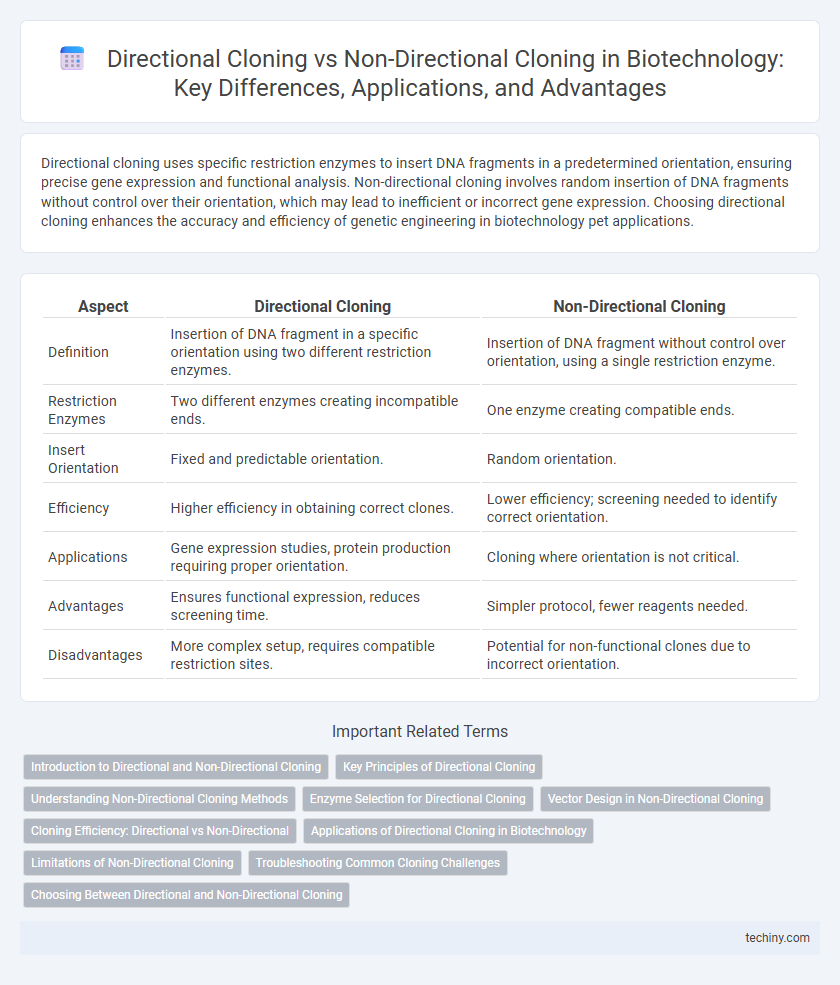Directional cloning uses specific restriction enzymes to insert DNA fragments in a predetermined orientation, ensuring precise gene expression and functional analysis. Non-directional cloning involves random insertion of DNA fragments without control over their orientation, which may lead to inefficient or incorrect gene expression. Choosing directional cloning enhances the accuracy and efficiency of genetic engineering in biotechnology pet applications.
Table of Comparison
| Aspect | Directional Cloning | Non-Directional Cloning |
|---|---|---|
| Definition | Insertion of DNA fragment in a specific orientation using two different restriction enzymes. | Insertion of DNA fragment without control over orientation, using a single restriction enzyme. |
| Restriction Enzymes | Two different enzymes creating incompatible ends. | One enzyme creating compatible ends. |
| Insert Orientation | Fixed and predictable orientation. | Random orientation. |
| Efficiency | Higher efficiency in obtaining correct clones. | Lower efficiency; screening needed to identify correct orientation. |
| Applications | Gene expression studies, protein production requiring proper orientation. | Cloning where orientation is not critical. |
| Advantages | Ensures functional expression, reduces screening time. | Simpler protocol, fewer reagents needed. |
| Disadvantages | More complex setup, requires compatible restriction sites. | Potential for non-functional clones due to incorrect orientation. |
Introduction to Directional and Non-Directional Cloning
Directional cloning involves the insertion of a DNA fragment into a vector in a specific orientation using two different restriction enzymes, ensuring correct gene expression and functionality. Non-directional cloning uses a single restriction enzyme, allowing the fragment to insert in either orientation, which may require additional screening to identify clones with the desired insert direction. Both methods play crucial roles in genetic engineering, with directional cloning offering greater precision for gene function studies.
Key Principles of Directional Cloning
Directional cloning ensures the precise insertion of DNA fragments into vectors by using two different restriction enzymes, creating non-compatible ends that enforce a specific orientation. This method enhances the efficiency of gene expression and functional studies by maintaining the correct reading frame and avoiding insert inversions. Non-directional cloning, in contrast, utilizes a single restriction enzyme, resulting in random orientation of inserts and potential downstream complications.
Understanding Non-Directional Cloning Methods
Non-directional cloning methods involve inserting DNA fragments into vectors without controlling the orientation of the insert, which can lead to multiple possible configurations during ligation. This approach simplifies the cloning procedure by avoiding the need for specific restriction enzyme sites but requires subsequent screening to identify clones with the correct insert orientation. Non-directional cloning is often used when insert orientation is less critical or when restriction sites are limited, though it may decrease cloning efficiency compared to directional cloning techniques.
Enzyme Selection for Directional Cloning
Enzyme selection for directional cloning involves using two different restriction enzymes that create non-compatible cohesive ends, ensuring the insert DNA is ligated into the vector in a specific orientation. This method reduces the likelihood of insert inversion and increases cloning efficiency by facilitating selective binding sites flanking the target sequence. Non-directional cloning typically uses a single restriction enzyme, which can result in random insert orientation, complicating downstream applications like expression analysis or functional studies.
Vector Design in Non-Directional Cloning
Vector design in non-directional cloning typically involves blunt-ended or single-enzyme linearized vectors that allow insert fragments to ligate in either orientation. This approach simplifies vector preparation but necessitates screening for correct insert direction due to the lack of specific orientation control. Non-directional cloning vectors often feature multiple cloning sites without asymmetric restriction sites, enabling versatile but less precise insert integration compared to directional cloning vectors.
Cloning Efficiency: Directional vs Non-Directional
Directional cloning significantly improves cloning efficiency by ensuring the insert DNA is ligated in a specific orientation, reducing the occurrence of non-functional recombinant plasmids. Non-directional cloning results in lower efficiency due to random insert orientation, often necessitating additional screening to identify correctly oriented clones. Optimizing enzyme selection and vector design in directional cloning enhances the success rate of generating functional recombinant constructs in biotechnology applications.
Applications of Directional Cloning in Biotechnology
Directional cloning is extensively applied in biotechnology for precise gene insertion, enabling the correct orientation of DNA fragments which is essential for proper gene expression and functional protein production. This technique facilitates the construction of recombinant DNA molecules for gene therapy, metabolic engineering, and production of recombinant proteins with high specificity and efficiency. It is pivotal in developing genetically modified organisms (GMOs) and synthetic biology applications by ensuring targeted gene integration and stable expression.
Limitations of Non-Directional Cloning
Non-directional cloning often results in the random insertion of DNA fragments, which can lead to a high proportion of recombinant clones carrying the insert in the wrong orientation, reducing cloning efficiency. This method complicates downstream applications such as protein expression or functional studies, as the insert's direction is crucial for proper transcription and translation. Furthermore, screening for clones with the correct insert orientation increases time and resource consumption compared to directional cloning techniques.
Troubleshooting Common Cloning Challenges
Directional cloning reduces the risk of incorrect insert orientation by using two different restriction enzymes, improving ligation efficiency and ensuring accurate gene expression. Non-directional cloning often leads to random insert orientation, which may require additional screening and sequencing to identify correct clones. Troubleshooting common cloning challenges involves verifying insert orientation through PCR or restriction analysis and optimizing enzyme digestion and ligation conditions to enhance cloning success rates.
Choosing Between Directional and Non-Directional Cloning
Choosing between directional and non-directional cloning depends on the specific goals of the experiment and the desired efficiency of insert integration. Directional cloning uses two different restriction enzymes to ensure the insert is ligated in a specific orientation, which is critical for downstream applications like protein expression or functional studies. Non-directional cloning employs a single restriction enzyme, allowing random insert orientation but offering simplicity and flexibility when insert direction is less crucial.
**Directional cloning vs Non-directional cloning** Infographic

 techiny.com
techiny.com